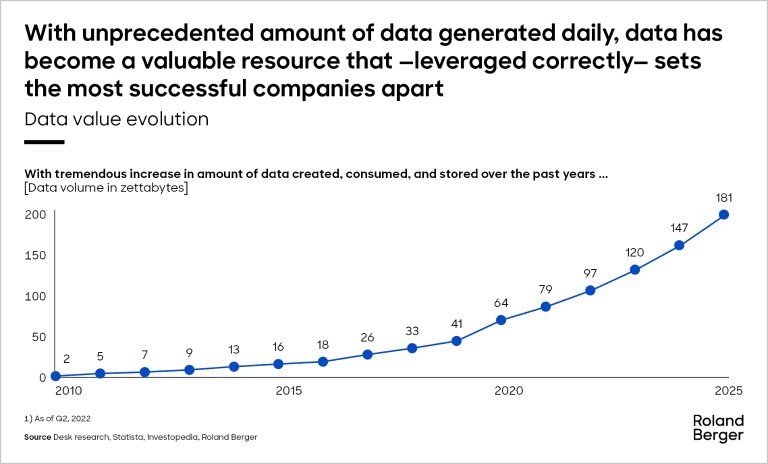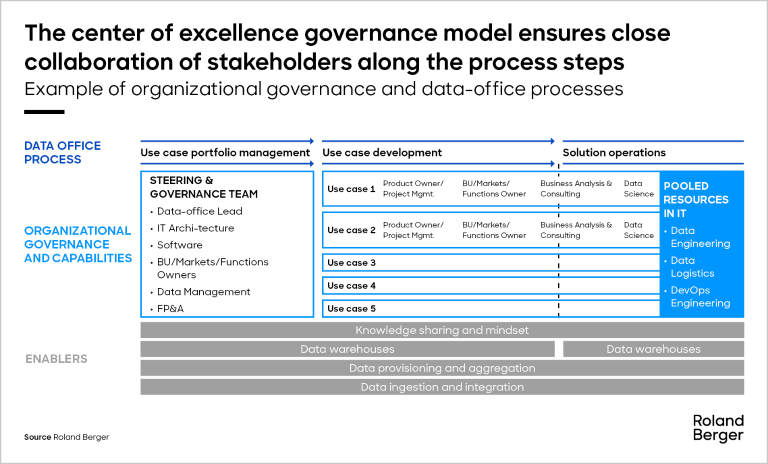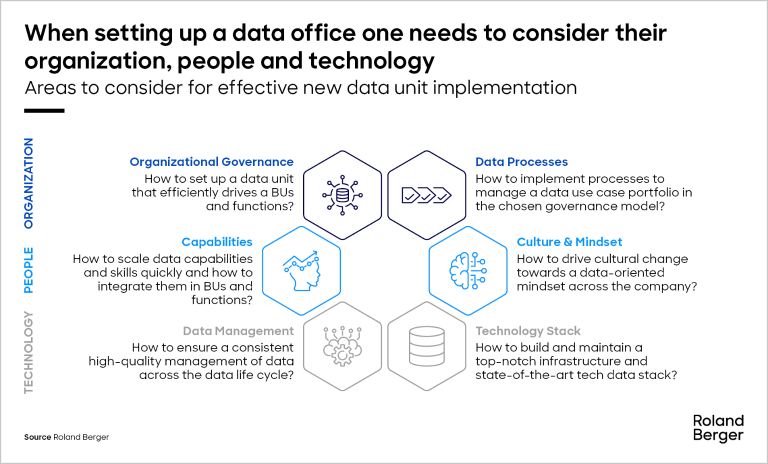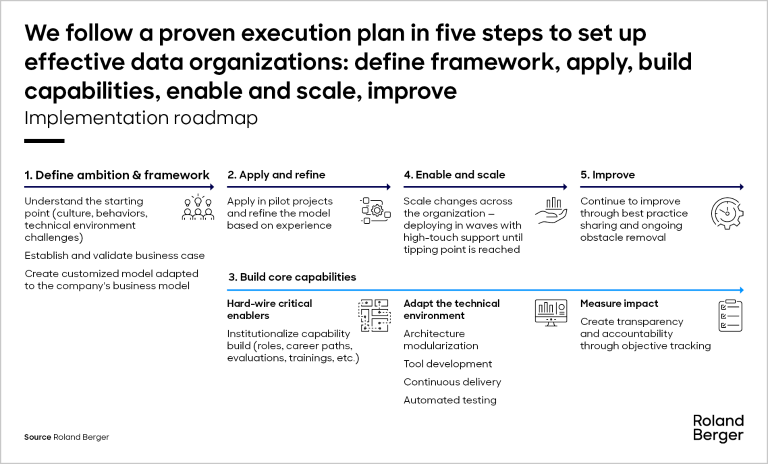How financial supervisory authorities can embrace big data.


From Data to Dominance: Accelerating Business Growth with a Data Office
The Importance of Data in the Digital Era: Driving Success and Revolutionizing Key Industries
In today's digital landscape, data has emerged as a critical driver of success, setting the most prosperous companies apart. With an unprecedented volume of data generated daily, the significance of leveraging data efficiently cannot be overstated. Over the past few years, the creation, consumption, and storage of data have skyrocketed, with estimates predicting it to reach a staggering 180 zettabytes by 2025. Leading technology giants have been early adopters, harnessing the power of data to make informed decisions and mitigate risks. Remarkably, six out of the world's ten largest companies are driven by data. Data analysis has also brought about transformative changes across various industries, from healthcare, where patient data informs personalized treatment plans, to finance, where predictive analytics aids in assessing credit risks and customizing investment strategies.

What is a data-driven company/organization?
But what are data-driven organizations and how do they leverage data efficiently?
Data-driven organization places data at the core of their decision-making processes and operations and cultivates a culture that emphasizes data literacy, encourages data exploration, and values evidence-based decision-making. They leverage advanced analytics, artificial intelligence, and machine learning technologies to collect, analyze, and interpret vast amounts of data, enabling them to identify trends, patterns, and opportunities that might otherwise remain hidden. By doing so, these organizations are equipped to respond swiftly to market changes, make informed strategic choices, optimize processes, and enhance customer experiences, thereby gaining a significant competitive advantage.
Becoming a data-driven organization is more like running a marathon than a sprint. The path to success can be arduous, requiring organizations to navigate challenges and embrace change. Transitioning from a decentralized data management structure to a collaborative data model is a crucial step toward becoming fully data-driven. The rewards of this transformation are manifold, as data-driven companies experience an average annual growth rate of over 30%. They are also 20 times more likely to acquire new customers and six times more effective at retaining existing ones.
The collaborative data model strikes the right balance between decentralized advanced analytics functions and centralized data management governance.

Introducing a centralized data management structure can significantly enhance the effectiveness of analytics within enterprise organizations. By aggregating data from various sources into a unified platform, businesses can ensure the quality, accuracy, and consistency of their data. This standardization not only boosts the reliability of analytics but also streamlines the process, enabling data scientists and analysts to extract valuable insights more efficiently. Centralization also reinforces data security and compliance measures, guaranteeing the protection of sensitive information and adherence to regulatory requirements.
Moreover, centralized data facilitates seamless collaboration and knowledge sharing among departments. Teams can work with a common dataset, fostering innovation and enabling cross-functional analyses. This collaborative approach leads to a deeper understanding of customer behavior, market trends, and operational efficiencies. Additionally, centralized data management systems are scalable and cost-effective, enabling organizations to efficiently handle growing volumes of data without proportionally increasing expenses. By leveraging a centralized data infrastructure, businesses can make data-driven decisions, enhance customer experiences, and gain a competitive edge in the market.
What is data office? how is it different from CIO?
Contrary to common misconceptions from companies eager to get new insights from data and drive their strategic decisions, successfully leveraging data does not solely rely on implementing the latest data tools. It demands a holistic approach that encompasses achieving a data-driven culture, ensuring data quality and integrity, investing in continuous training and skill development, and establishing a robust data governance.
Recognizing this need, organizations have increasingly turned to a dedicated entity known as the Data Office. The Data Office is not only a centralized hub; it is the organization's guardian and navigator for data.
Its role goes beyond data collection to encompass data harnessing, beyond data storage to data utilization, and beyond data analysis to its integration into the core of strategic decision-making. Unlike the traditional Chief Information Office (CIO), which primarily focuses on managing IT infrastructure and technology systems, the Data Office's primary focus is on data itself and its strategic utilization. It takes on a broader perspective, encompassing the entire data lifecycle, from data collection and storage to data analysis and application.
This holistic approach allows the Data Office to facilitate seamless collaboration across departments and align data initiatives with the organization's strategic goals.
Pitfalls solved by a data office
Therefore, a data office will solve several pitfalls encountered by companies in their transformative journey to a data-driven organization:
- Data Silos:
Ensures data is accessible, integrated, and utilized consistently across the organization - Data Quality and Integrity Issues:
Establishes data quality standards, regular audits, and data cleansing processes - Lack of Data Strategy:
Formulates data strategy and priorities, identifies data sources, and outlines the roadmap for data-driven initiatives - Inefficient Data Management:
Establishes efficient data management practices: data governance frameworks, data cataloging, and data lifecycle management - Limited Data Literacy:
Promotes data literacy through training programs, workshops, and knowledge-sharing initiatives - Compliance and Privacy Risks:
Ensures that data handling adheres to regulatory requirements and privacy best practices - Uncoordinated Data Initiatives:
Acting as a central coordinator, it guarantees that data initiatives are well-integrated, strategically aligned, and contribute to the achievement of overarching business objectives. - Missed Opportunities: Monitors industry trends, emerging technologies, and data innovations to capitalize on new opportunities
Nonetheless, to evolve into an organization with the ability to unlock the full potential of data, the implementation of a robust data governance framework with the data office at its core is essential. As emphasized by international best practices, such a structure will help establish the prerequisites for a data-driven company, considering the organizational culture and the overall company ecosystem.

The implementation of a data office governance structure involves the adoption of various organizational models that have been refined by leading data-driven companies. These models are typically customized to suit the specific needs and characteristics of an organization.
At Roland Berger, we recommend two highly effective models, which we have honed through our extensive experience in the data field: the center of excellence and federated governance models. These models foster close collaboration among stakeholders throughout the entire process, ensuring seamless execution. As an example, we present the Center of Excellence organizational governance, where capabilities and cross-functional teams are established and involved in various data office process steps, including portfolio management, use case development, and solution operations.

Moreover, organizations embarking on a data transformation journey choose between two traditional approaches: the top-down approach and the value-driven approach. The top-down approach focuses on developing a comprehensive data strategy and associated data management processes as the foundation for building use cases. While this approach ensures centralized data strategy and quality, it requires significant investment and time before an exhaustive and operational data foundation is established.
In contrast, the value-driven approach is more agile, placing immediate value creation at the forefront by implementing individual use cases while simultaneously constructing the necessary data foundation. This approach allows rapid implementation, early value generation, and iterative optimization of data structures and strategy. However, as data availability and quality are evaluated for individual applications, it may lead to some inconsistencies at the overall company level.
At Roland Berger, we harmonize the strengths of both approaches, enabling our clients to achieve quicker results while maintaining a holistic perspective, ensuring quality and consistency across the organization.
Ultimately, when establishing a data office, organizations must carefully consider their organization, people, and technology to ensure successful implementation. Key questions around organizational governance and data processes, capabilities and culture & mindset, data management and technology stack should be addressed.

Challenges to setting up a data office
Setting up and maintaining a data office is not an easy task and comes with a set of challenges. To ensure a successful operationalization, companies should remain mindful of key success factors:
- Collaborate with IT:
Ensure tight collaboration between the Data Office and IT departments - Prepare for scalability:
Design your data office with scalability in mind - Frame your data-office set up with business goals in mind
Let business objectives guide the implementation instead of an IT-centric approach. - Ensure management support
Strong mandate of management to ensure success of implementation - Decide how to allocate resources for implementation
Ensure the availability of resources for the implementation project team; meticulous planning of resource allocation can prevent issues in the future. - Start cultural change
Develop the data office with a business-centric approach; prioritize cultural change over skills. - Measure results
Set KPIs, track data quality, and measure impact on revenue and costs
At Roland Berger, we have developed a five-step implementation approach that we adhere to and customize to assist companies in establishing or revitalizing their data organizations.

By following this roadmap, organizations can navigate their data transformation journey with confidence, unlocking the full potential of data-driven decision-making and propelling their business to new heights.
At Roland Berger, we understand the strategic significance of data and have helped numerous clients establish successful data offices and achieve tangible results through data-driven insights.
Going beyond: harmonizing data and AI
Organizations must recognize the symbiotic relationship between data and AI. As highlighted by the massive abundance of digital data insight, AI systems, particularly those based on Machine Learning, require large datasets to learn and evolve. Every online interaction, transaction, or sensor activation contributes to the pool of digital data essential for training these models. With the rapid growth of digital data, the sophistication of AI models and applications will also increase.
In this context, the role of a Data Office is absolutely crucial. As a centralized hub responsible for orchestrating, governing, and optimizing data strategy and operations, the Data Office ensures the availability and seamless integration of extensive datasets into AI initiatives. By aligning AI endeavors with the overarching data governance structure championed by the Data Office, organizations can unlock the full potential of AI, making informed decisions, uncovering patterns, and maintaining a competitive edge in the swiftly evolving digital realm. The symbiotic relationship between a robust Data Office and the advancement of AI models paves the way for unparalleled business expansion and innovation.





